You know what's funny? My brother Ian, who rarely spends time in the kitchen, surprised me one weekend by making this incredible Beef Salpicao that transported me straight back to our favorite Filipino restaurant in Balanga, Bataan.
When I asked where he learned it, he sheepishly admitted that after spending too much money on takeout beef salpicao, he decided to master it at home.
The way the butter-garlic sauce coats each piece of tender beef, paired with sinangag (garlic rice), it's the kind of comfort food that makes any tough day better. Now that he's taught me his secrets, I can't believe how simple yet impressive the dish is.
This restaurant-style Filipino Beef Salpicao recipe will become your new kitchen superstar.
Jump to:
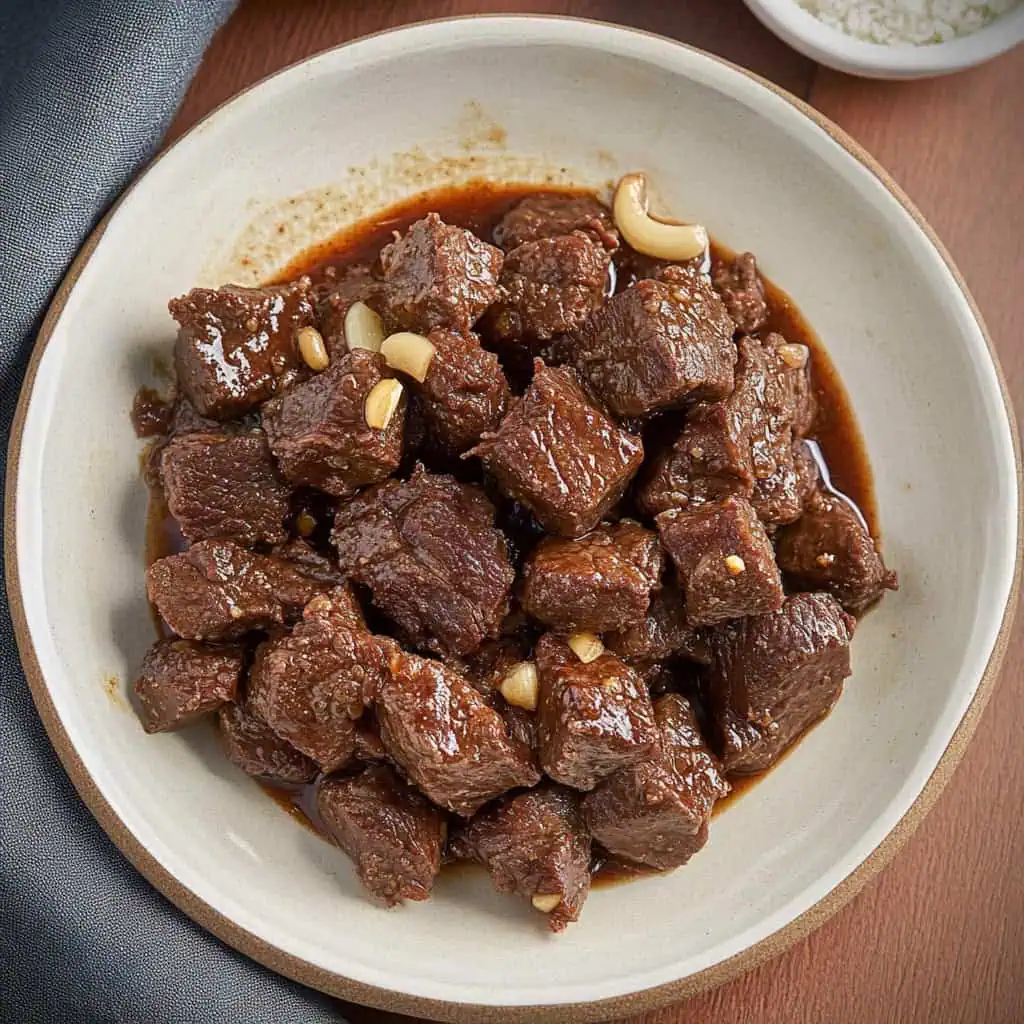
Why You'll Love This Recipe
- Ready in just 25 minutes - perfect for busy weeknights
- Restaurant-quality dish at a fraction of the cost
- Simple ingredients but complex, rich flavors
- Versatile - works as both pulutan (appetizer) or main dish
- Customizable spice levels to suit your taste
- Impressive enough for special occasions
- One-pan cooking for easy cleanup
Ingredients
The ingredients in Filipino Beef Salpicao work together to create a perfect balance of flavors and textures. Ribeye steak provides rich marbling that keeps the meat juicy and tender when quickly seared at high heat.
The generous amount of fresh garlic is the dish's signature, creating a deeply aromatic foundation that's enhanced by butter's richness. Worcestershire and soy sauce add umami depth while balancing each other's intensity, and brown sugar helps the sauce caramelize on the meat. A hint of chili flakes adds gentle warmth without overwhelming the dish.
The olive oil's higher smoke point protects the butter from burning during high-heat cooking, ensuring you get perfect flavor without bitterness. These ingredients, when combined, create a luxurious yet simple dish that's greater than the sum of its parts.
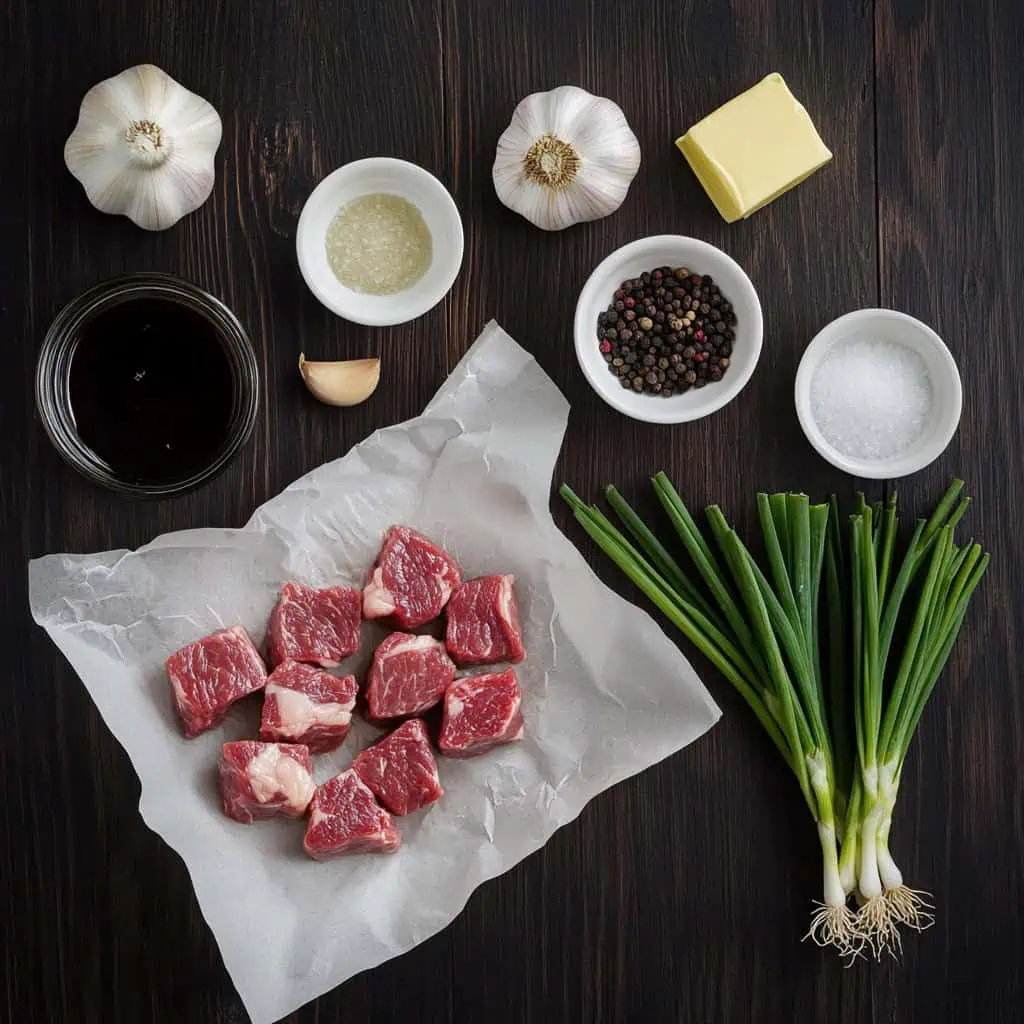
- 2 pounds ribeye steak, cut into 1-inch cubes
- Salt and freshly ground black pepper to taste
- 2 tablespoons Worcestershire sauce
- 2 tablespoons soy sauce
- 1 teaspoon brown sugar
- ¼ teaspoon red chili pepper flakes
- 2 tablespoons butter
- 1 tablespoon olive oil
- 1 whole head garlic, peeled and minced
- Optional garnish: chopped green onions and crispy fried garlic bits
Equipment
- Large heavy-bottomed skillet or wok - For proper searing and heat distribution, ensuring your beef gets that perfect brown crust while maintaining tenderness
- Sharp knife - For cutting beef into uniform pieces, which helps ensure even cooking
- Cutting board - Preferably wooden for meat preparation, as it won't dull your knife as quickly as plastic or glass
- Garlic press - Optional, for quickly mincing large amounts of garlic without hand fatigue
- Kitchen tongs - For easy meat handling and flipping during the searing process
- Small bowls - For mise en place (organizing ingredients before cooking)
- Measuring spoons and cups - For precise measurements, especially important for the sauce ratios
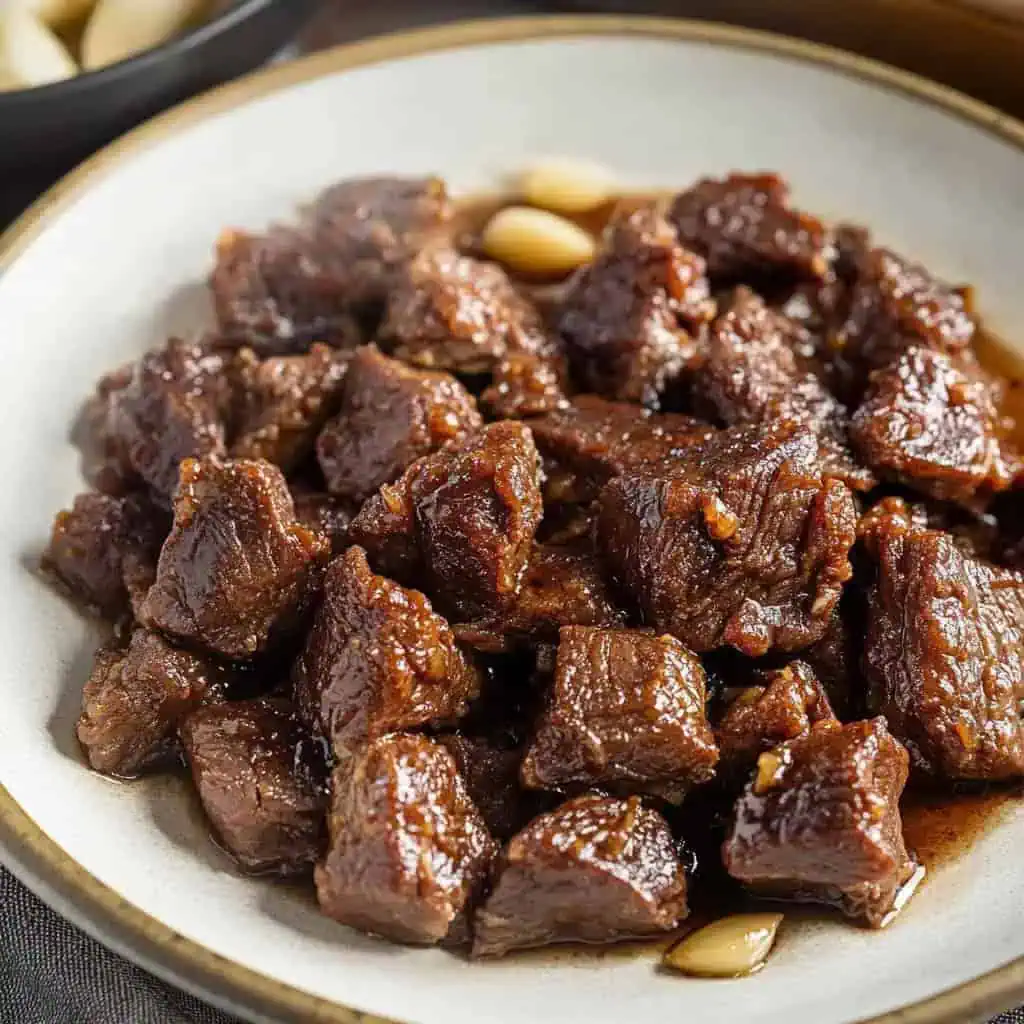
How To Make
- Pat dry 2 pounds of ribeye steak cubes with paper towels. Season generously with salt and freshly ground black pepper. Let the meat marinate at room temperature (25°C) for 10 minutes.
- While the meat marinates, prepare the sauce. In a small bowl, whisk together 2 tablespoons each of Worcestershire sauce and soy sauce, 1 teaspoon brown sugar, and ¼ teaspoon red chili pepper flakes. Stir until the sugar completely dissolves.
- Heat a large heavy-bottomed skillet or wok over medium heat (180°C). Add 2 tablespoons butter and 1 tablespoon olive oil. Once the butter melts but before it gets too hot, add one whole head of minced garlic. Cook until the garlic turns light golden brown, about 1-2 minutes.
- Increase heat to high (230°C). Add the seasoned beef in a single layer, being careful not to overcrowd the pan. Sear the meat for 1-2 minutes per side until nicely browned. If needed, cook in batches to ensure proper searing.
- Pour in the prepared sauce mixture and cook for 3-5 minutes for medium-rare, stirring occasionally to coat the meat evenly. The internal temperature should reach 63°C/145°F for medium-rare.
- Remove from heat and let rest for 2-3 minutes. Garnish with chopped green onions and crispy fried garlic bits if desired. Serve immediately while hot, ideally with sinangag (garlic rice) or steamed white rice.

Tips from Lola's Kitchen
- Select the right beef: Choose cuts with good marbling for maximum flavor. The fat distributed throughout the meat will melt during cooking, creating juicier, more flavorful results.
- Proper cutting technique: Always cut your beef against the grain for maximum tenderness. This means slicing perpendicular to the muscle fibers, which shortens them and makes each bite easier to chew.
- Room temperature meat: Always let your beef rest at room temperature for 15-20 minutes before cooking. Cold meat directly from the refrigerator will seize up in a hot pan, resulting in tough texture.
- Don't rush the garlic: Cook garlic slowly at first to extract maximum flavor without burning. Burnt garlic becomes bitter and can ruin the entire dish.
- The power of batches: Never overcrowd your pan when searing beef. Cook in batches if necessary - each piece needs space to create that beautiful sear without steaming.
- Resting period: Allow the beef to rest a few minutes after cooking. This lets the juices redistribute throughout the meat instead of spilling out when cut.
- Finish with freshness: A last-minute sprinkle of green onions adds brightness that balances the rich flavors of the dish.
Substitutions
- Beef cuts: While ribeye is traditional, you can use tenderloin for an even more tender (though less flavorful) result. Sirloin offers a good balance of flavor and tenderness at a lower price point.
- Oils: Don't have olive oil? Use canola or vegetable oil instead. The important part is combining some type of oil with the butter to prevent burning.
- Garlic alternatives: In a pinch, you can use 1 tablespoon of garlic powder, though fresh garlic provides significantly better flavor and texture.
- Worcestershire sauce: Substitute with a mixture of 1½ tablespoons oyster sauce and ½ tablespoon vinegar for a similar depth of flavor.
- Sweeteners: White sugar or honey can replace brown sugar if needed. For honey, use slightly less (¾ teaspoon) as it's sweeter than sugar.
- Heat element: No red pepper flakes? Use a pinch of cayenne powder, a small amount of sriracha, or a finely chopped fresh chili.
Troubleshooting
- Tough meat: If your beef turns out tough, you've likely either overcooked it or cut with the grain. For next time, reduce cooking time and ensure you're cutting against the grain.
- Burnt garlic: Burnt garlic creates an unpleasant bitter taste. This usually happens when you add garlic to already hot oil/butter. Solution: Add garlic to warm (not hot) fat and monitor closely.
- Watery sauce: A watery sauce typically results from overcrowding the pan or using wet meat. Always pat meat dry before cooking and use a large enough pan to allow proper evaporation.
- Lack of flavor: If your dish tastes bland, you likely need more salt or didn't get a proper sear. Season adequately and ensure your pan is hot enough when searing the beef.
- Greasy result: Too much oil or butter can make the dish overly greasy. Stick to the recommended amounts, and if needed, you can blot excess oil with paper towels before serving.
Storage & Reheating
- Refrigeration: Store leftover beef salpicao in an airtight container for up to 3 days. The flavors often deepen overnight, making day-two salpicao especially delicious.
- Freezing: Not recommended as freezing affects the meat's texture and can make it tough when reheated. The garlic flavor also diminishes after freezing.
- Reheating on stovetop: For best results, quickly reheat in a hot skillet for just 1-2 minutes until warmed through. Avoid extended cooking as this will toughen the meat.
- Microwave reheating: If using a microwave, reheat in 30-second intervals at 70% power, stirring between intervals. Stop as soon as it's warm to avoid overcooking.
- Revitalizing leftovers: Add a small pat of fresh butter and a sprinkle of chopped garlic when reheating to refresh the flavors.
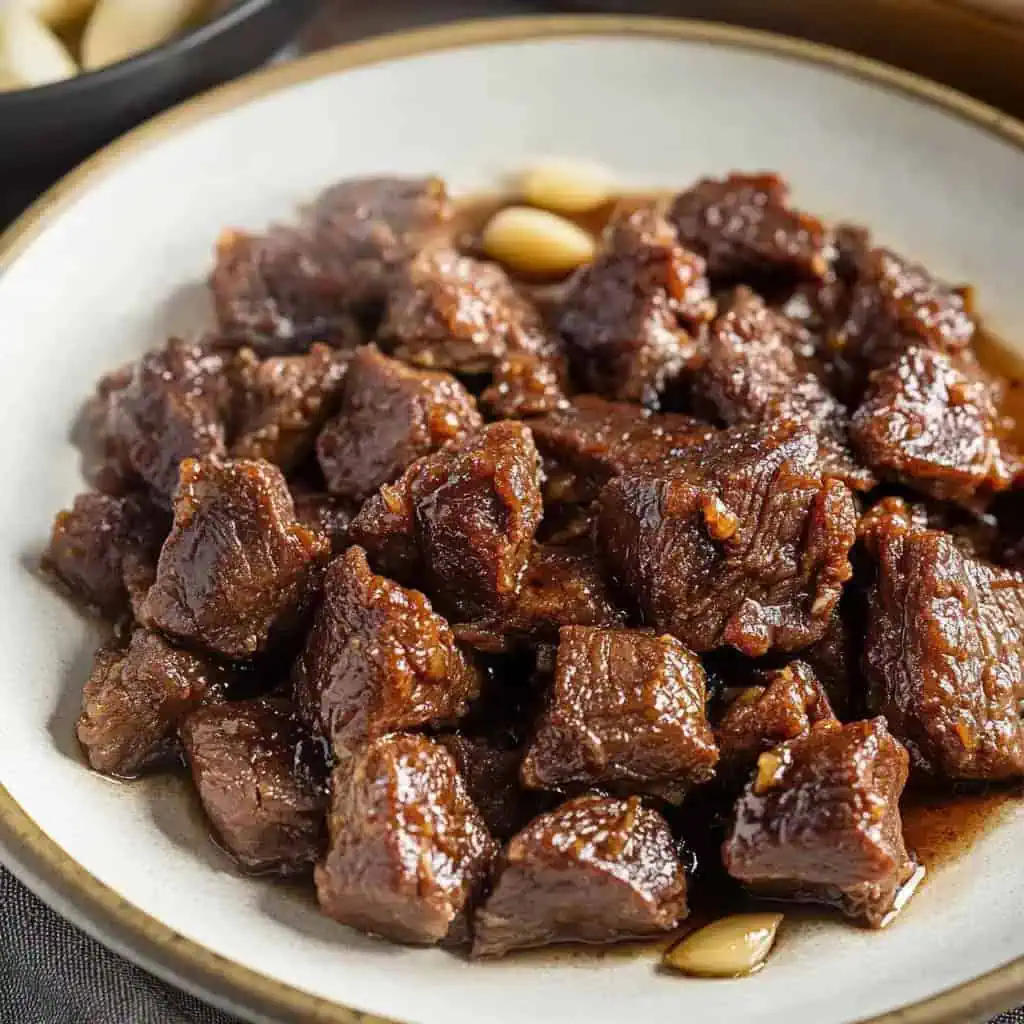
FAQ
Why is my beef not browning well?
Ensure your meat is completely dry before cooking, your pan is very hot, and you're not overcrowding the pan. Each piece of beef needs space for moisture to evaporate and browning to occur.
Can I make this ahead for a party?
While best served fresh, you can prepare all ingredients ahead of time and cook just before serving. If absolutely necessary, you can cook it 1-2 hours ahead and keep warm in a low oven (170°F/75°C), but the meat texture won't be as perfect.
Is it okay to use pre-minced garlic?
Fresh garlic provides significantly better flavor. Pre-minced garlic in jars often lacks the same punch and can contain preservatives that alter the taste.
Can I use butter only instead of butter + oil?
The oil helps prevent butter from burning at high heat. Using only butter increases the risk of burned butter, which tastes bitter. The combination gives you the flavor of butter with the higher smoke point of oil.
How spicy is this dish?
With the recommended amount of chili flakes, it's mildly spicy. You can easily adjust by adding more chili flakes for heat lovers or reducing/omitting for those sensitive to spice.
What's the best doneness level for beef salpicao?
Medium-rare to medium (145°F-160°F internal temperature) is ideal. The quick cooking method helps preserve tenderness while developing flavor.
Can I add vegetables to this dish?
Absolutely! Bell peppers, mushrooms, or onions make excellent additions. Add them after searing the beef but before adding the sauce.
What's the difference between beef salpicao and beef stir-fry?
The key differences are the generous amount of garlic and the specific sauce blend. Salpicao has a distinctive garlic-forward flavor profile with a butter base, while stir-fries typically use different sauce combinations and cooking techniques.
Related
Looking for other recipes like this? Try these:
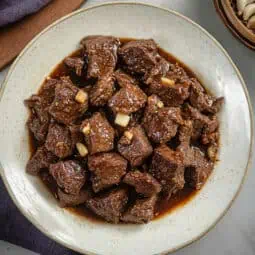
Filipino Beef Salpicao (Ginisang Beef sa Bawang)
Equipment
- Large heavy-bottomed skillet or wok (kawali) For proper searing and heat distribution
- Sharp knife (kutsilyo) For cutting beef into uniform pieces
- Cutting board (Tabla) Preferably wooden for meat preparation
- Garlic press (pandurog ng bawang) Optional, for mincing garlic
- Kitchen tongs (Sipit) For easy meat handling
- Small bowls (mangkok) For mise en place
- Measuring spoons and cups (panukat) For precise measurements
Ingredients
For the Beef
- 2 pounds ribeye steak baka, cut into 1-inch cubes (Tagalog: kinatay na baka)
- Salt asin and freshly ground black pepper (paminta) to taste
For the Sauce
- 2 tablespoons Worcestershire sauce
- 2 tablespoons soy sauce toyo
- 1 teaspoon brown sugar asukal na pula
- ¼ teaspoon red chili pepper flakes pulang siling durog
For Cooking
- 2 tablespoons butter mantikilya
- 1 tablespoon olive oil
- 1 whole head garlic isang buong bawang, peeled and minced
Optional Garnish
- Green onions dahon ng sibuyas, chopped
- Crispy fried garlic bits toasted na bawang
Instructions
- Pat dry 2 pounds of ribeye steak cubes with paper towels. Season generously with salt (asin) and freshly ground black pepper (paminta). Let the meat marinate at room temperature (25°C) for 10 minutes.
- While the meat marinates, prepare the sauce (sarsa). In a small bowl, whisk together 2 tablespoons each of Worcestershire sauce and soy sauce (toyo), 1 teaspoon brown sugar (asukal na pula), and ¼ teaspoon red chili pepper flakes (pulang siling durog). Stir until the sugar completely dissolves.
- Heat a large heavy-bottomed skillet or wok (kawali) over medium heat (180°C). Add 2 tablespoons butter (mantikilya) and 1 tablespoon olive oil. Once the butter melts but before it gets too hot, add one whole head of minced garlic (isang buong bawang). Cook until the garlic turns light golden brown, about 1-2 minutes.
- Increase heat to high (230°C). Add the seasoned beef in a single layer, being careful not to overcrowd the pan. Sear the meat for 1-2 minutes per side until nicely browned. If needed, cook in batches to ensure proper searing.
- Pour in the prepared sauce mixture and cook for 3-5 minutes for medium-rare, stirring occasionally to coat the meat evenly. The internal temperature should reach 63°C/145°F for medium-rare.
- Remove from heat and let rest for 2-3 minutes. Garnish with chopped green onions (dahon ng sibuyas) and crispy fried garlic bits (toasted na bawang) if desired. Serve immediately while hot, ideally with sinangag (garlic rice) or steamed white rice.
Tips from Lola's Kitchen
- Choose beef with good marbling for the best flavor
- Cut meat against the grain (patihaba) for maximum tenderness
- Don't overcrowd the pan - cook in batches if needed
- Let meat rest at room temperature before cooking
- Use fresh garlic, never pre-minced
- Keep the pan very hot while cooking the beef
Nutrition
The Story Behind Beef Salpicao
Beef Salpicao stands as a delicious testament to the Philippines' rich culinary heritage, where Spanish influence meets Filipino creativity. The dish's name originates from the Spanish word "salpicar," meaning to spatter or sprinkle, perfectly describing how the golden-brown garlic bits generously dot each piece of tender beef.
While its exact origins remain debated among Filipino food historians, beef Salpicao emerged during the Spanish colonial period, likely inspired by the Spanish dish Solomillo al Ajillo (garlic-studded beef tenderloin). However, Filipino cooks transformed this European dish by incorporating distinctly Asian elements like soy sauce and creating a more intensely garlicky profile that appeals to the Filipino palate.
What began as a high-end restaurant dish in Manila's prestigious dining establishments during the 1970s has evolved into a beloved staple in Filipino homes. Traditionally served in sizzling plates in restaurants, home cooks discovered that this seemingly fancy dish was surprisingly accessible to make. The combination of tender beef, aromatic garlic, and rich butter sauce quickly earned it a place in both casual pulutan (bar food) culture and special family gatherings.
Today, Beef Salpicao represents the perfect marriage of Filipino and Spanish cuisines, demonstrating how global influences shaped modern Filipino cooking. Whether served in upscale restaurants in Makati's business district or prepared for family dinners in homes across the Philippines, this dish continues to capture the essence of Filipino fusion cuisine - unpretentious yet sophisticated, simple yet memorable.
Modern Filipino chefs continue to reinvent Beef Salpicao, creating variations with mushrooms, adding local chilies, or serving it with different starches, but the heart of the dish remains unchanged - perfectly seared beef swimming in a garlic-infused butter sauce that keeps Filipinos coming back for more.
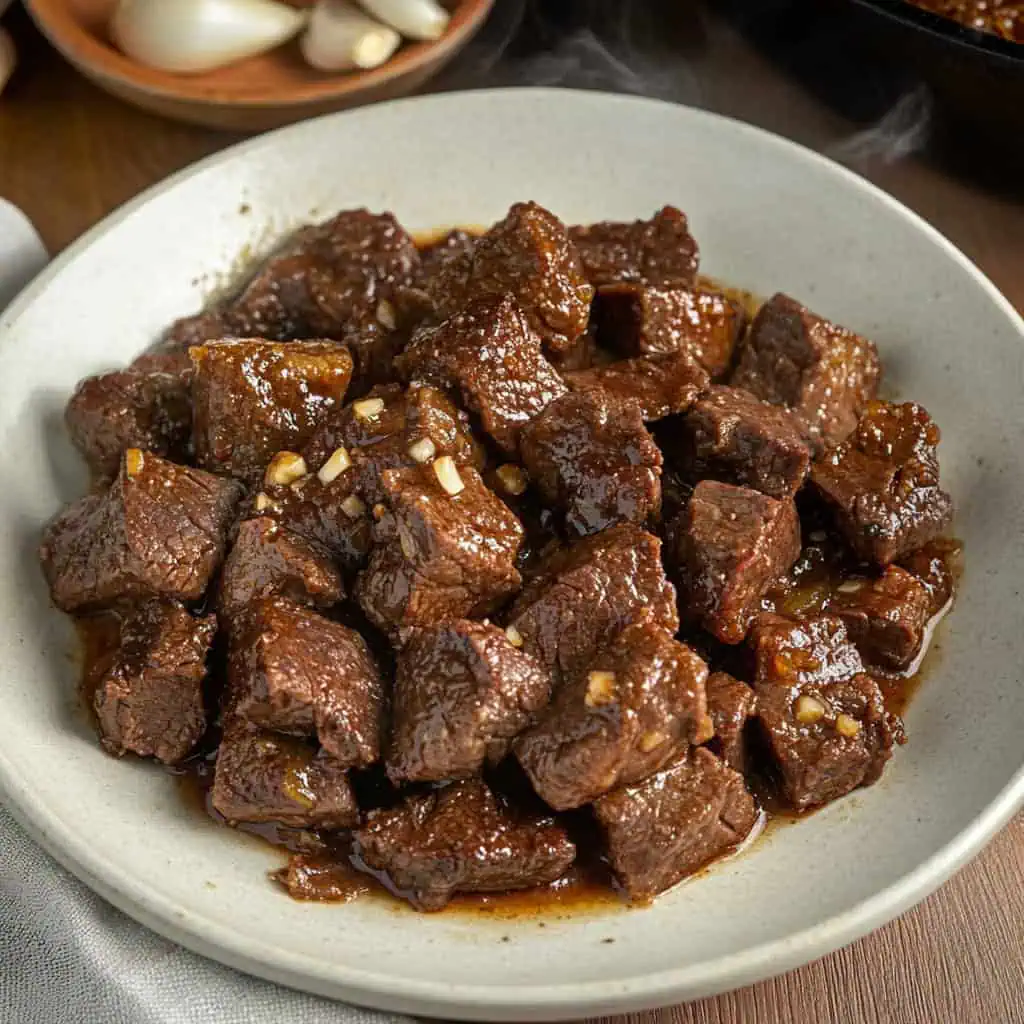









Comments
No Comments